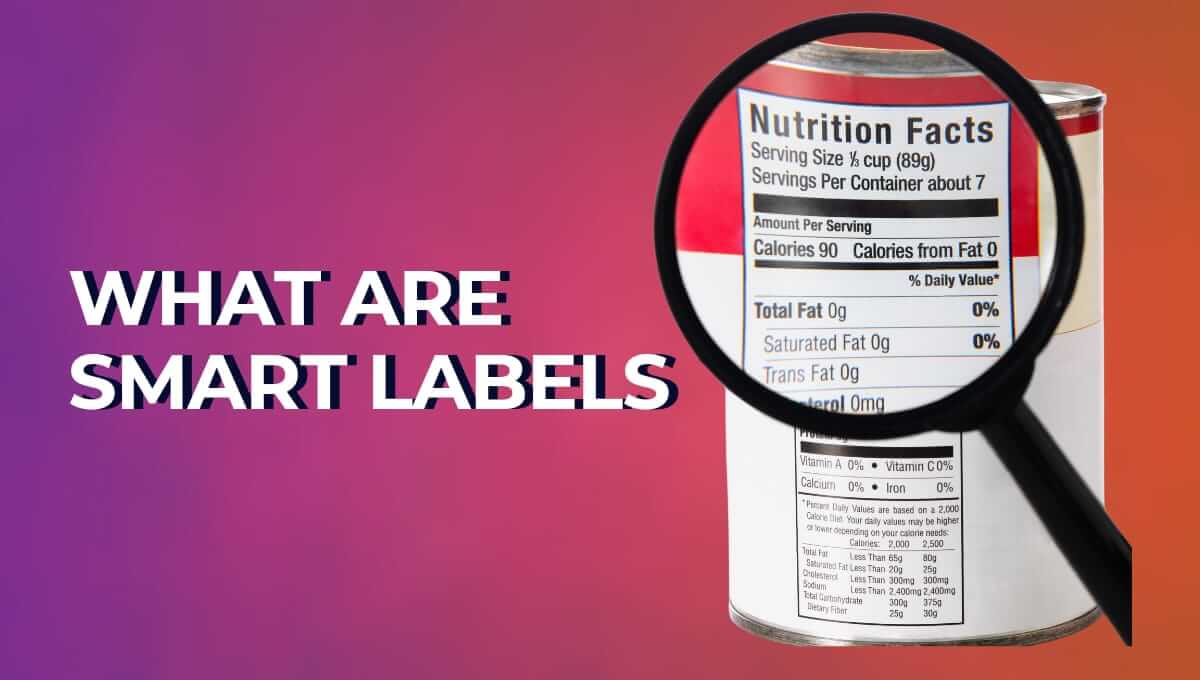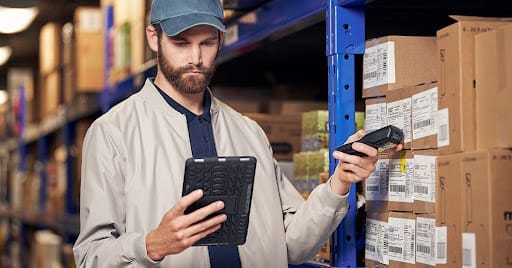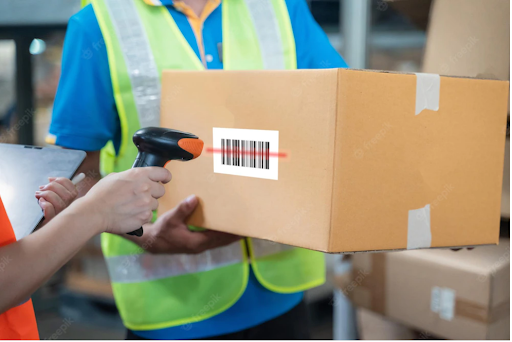What are Smart Labels?

Smart labels are technological innovations seamlessly incorporated into labeling methods. They have modernized this industry and allow brands to connect with their target audience interactively.
Smart labels are not limited to identification. They go beyond that by offering real-time data tracking, better security, and customer engagement.
Every business wants to increase efficiency and manage inventory while maintaining product authenticity. Smart labels emerge as a much-needed solution for such businesses.
But what are smart labels? How do they work? And are they right for your business?
In this guide, we'll explore smart labels, their functionality, and much more. It'll help you understand how smart labels can benefit your business and how to implement them.
So keep reading.
What Are Smart Labels?
Smart labels are also known as intelligent labels or smart packaging. These labels are equipped with advanced technology through which customers can interact with supply chains and even the products themselves. But is it limited to the only?
No. It's more than that.
They serve as identifiers and provide valuable information and functionality.

Sources: att
Types of Smart Labels
There are seven primary types of smart labels. Generally, they come in various forms, but these seven are the most important.
QR Code Labels
These are also known as Quick Response code labels. A QR code is a two-dimensional barcode that stores data. It can be URLs, texts, context, or even geo-coordinates. Traditional barcodes are readable in only one direction and don't hold large amounts of data. However, these QR code labels are becoming more advanced and can contain large information. They are customizable and allow brands to add their logos, which ultimately helps improve brand recognition.
The main advantage of these labels is that they are easy to use and accessible. Since every smartphone has scanning features, customers no longer need specialized equipment.
Data Embedded Barcodes
The GS1-128 is an extension of the traditional system used for barcodes. It can hold details such as batch number, expiry date, batch, and other information that is helpful for users. A reader can access them using barcode readers. Here's how it works.
Scan the barcode → Decode information → Get data for inventory management, tracking, and logistics purposes.
These barcodes are widely used in full-chain management, especially in warehousing and retail. They're pivotal in making inventory and product tracking even more efficient.
Radio-Frequency Identification Tags

Source: inetra.ai
RFID tags utilize electromagnetic fields through which you can automatically identify and track any objects that are attached to them. These tags can be in different forms, such as:
- Active
- Passive
- Semi Passive
RFID readers scan the stored data further. They are used in inventory management and related tasks. RFID tags are unique because they can scan multiple items at a time, and there's no need for direct line-of-sight.
Near Field Communication Tags
NFC tags are a subtype of RFID technology. However, it is different from RFID because it's designed for close-proximity communication. The distance is generally within a few centimeters. Most commonly, this technology is used in contactless payment systems, electric ticketing, and safe access control processes.
Time Temperature Indicators

Source: pdchealthcare
TTIs are smart labels that monitor and record a product's temperature history. They are significant in the food and pharmaceutical industries because maintaining proper temperature is critical for safety and product quality. Time Temperature Indicators change color or show a visual signal when the product is exposed to a temperature beyond its predetermined range.
Electronic Shelf Labels
ESLs are used in retail environments and show pricing and data in digital form on the shelves. The best part about ESLs is that they can be updated remotely. That means you can make promotional changes, price changes, and much more. ESL helps you improve pricing accuracy and eliminate labor costs with manual tagging. Overall, it contributes to environmental sustainability by eliminating paper usage.
E-ink Labels

Source: bakeryandsnacks
You can tell by the name that E-ink labels use electronic ink technology to display information, similar to e-readers. They're an energy-efficient alternative and perfectly readable even in different lighting conditions. You can update them wirelessly.
Overall, it's a cost-effective and durable labeling approach. It is used in various applications, such as displaying information in retail stores, museums, and more.
How Does a Smart Label Work?
Smart labels incorporate advanced technology into traditional labeling, transforming boring labels into interactive, data-rich experiences. Remember, the working method of smart labels varies according to their type. However, the core principle of this technology remains the same. It generally revolves around storing and transmitting data so it becomes accessible.
Storage And Encoding Of Data
The unique ability of smart labels is to store vast amounts of data, ranging from general identification information to detailed tracking logs. Let's understand this with an example.
A QR code label encodes data in a visual pattern. A user can scan this pattern from a smartphone to access readable information. Meanwhile, an RFID tag stores data in a microchip, which is readable through radio waves. Likewise, information in NFC tags can be found when they are in close proximity.
Engagement With Readers
In this step, your customer or reader interacts with the smart label. QR codes and barcodes can be scanned optically with the help of smartphones. But it's not the same for other labels as well.
RFID and NFC tags communicate using electromagnetic fields or radio waves. This is significant for non-contact reading in a fast-paced environment. Remember that reading conditions may vary. With RFID tags, readability is limited, and it changes according to the technology you utilize.
Processing Of Data & Using
After reading the smart label, it's time to process and utilize it for various purposes. When a user scans a QR code on a product, they can be led to a webpage with detailed information. But how can it help in inventory management?
With RFID data, you can track inventory much better. It can also help you monitor goods movement and automate order processing. Furthermore, it's also used to improve customer engagement and gain more business insights.
Integrate With Systems
Smart labels are integrated with systems for data management and analysis. The integration includes cloud-based platforms or IoT technologies, which means the system can handle even larger data volumes.
The labels work by embedding digital technology into traditional labels. Their versatility and adaptability make smart labels an integral part of several industries. They interact with data, adding value not just for customers but also for businesses.
Benefits of Smart Label Technology
Now that you know about smart labels, let's dive deeper and learn more about their benefits.

Source: linkedin
Enhanced Supply Chain Visibility
Smart labels improve real-time tracking and monitoring of products throughout the supply chain. It's not limited to production facilities, end consumers, etc. The improved visibility helps optimize business inventory and its management at all scales. You can manage stocks, reduce stockouts, and improve supply chain efficiency.
Enhanced Consumer Engagement
Customer satisfaction is crucial for any business's success. But how do smart labels help with that?
With smart labels, consumers can get detailed product information, including ingredients, nutritional content, and usage instructions. This transparency improves customer trust and loyalty, empowering them to make informed purchasing decisions based on their preferences and values.
Streamlined Compliance and Regulation
Compliance with rules and regulations is important for business. But how can you make sure that every product is made in compliance with regulatory requirements and industry standards?
It's possible to do it through smart labels. Smart labeling technology simplifies compliance tasks by automating data capture and documentation processes. Moreover, the risk of non-compliance penalties.
What Industries Benefit From Smart Labeling Technology?
Smart labeling technology isn't just limited to one industry. There are several industries where it could be of great significance. Here are some of the Industries that could incorporate this technology.
- Retail: Improve inventory management and an opportunity to engage better with customers by providing advanced information related to the product.
- Healthcare: Ensuring the safety of patients and giving accurate medication. It also includes tracking medications and proper management of assets.
- Logistics and Supply Chain: Makes tracking smooth and eliminates errors, improving the supply chain's efficiency.
- Food and Beverage: Analyze temperature-sensitive products to ensure compliance with quality and safety standards.
- Manufacturing: Helpful in tracking components and finished products for quality control.
Ending Thoughts
Smart labels are a significant advancement in labeling technology. They provide several benefits across various industries and serve as proven versatile tool. Smart labels are invaluable for improving inventory management, customer management, product authenticity, and industry safety.
This technology's cost and environmental impact may vary according to the type and scale of implementation. It's important to evolve processes with technological advancement.
If you want your business to grow, it's time to adopt smart labels. That's how you can improve your business and keep up with changing technologies. It's also helpful in gaining a competitive advantage.
If you want further details regarding improving your labels, contact our team of experts today. We are here to assist you in leveling up your labels.
